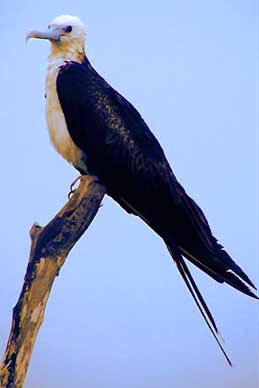MAGNIFICENT FRIGATEBIRD
 Immature Magnificent Frigatebird, photo by Cotting White |
 Immature Magnificent Frigatebird, photo by Cotting White |
Magnificent Frigatebirds are "kleptoparasites" -- they sometimes chase down birds of other species and steal their food. This may even amount to forcing victims to regurgitate food already eaten.
One study conducted in Mexico found that Magnificent Frigatebird kleptoparasitism is often a two-step affair. A frigatebird's first attack on a potential victim can often be interpreted as "sizing up the victim." If the victim turns out to be a healthy, strong flier, the frigatebird typically breaks off the chase. But if the victim seems vulnerable, a long chase may take place, ending with an exchange of gut content.
But Karen wasn't concerned with any of that, just with the eerie and beautiful silhouette suspended above her, and I do believe that I saw in Karen's face a glimmer of primal recognition of the fact that the world is more surreal and full of the unexpected than on a sunny day we'd ever like to admit.